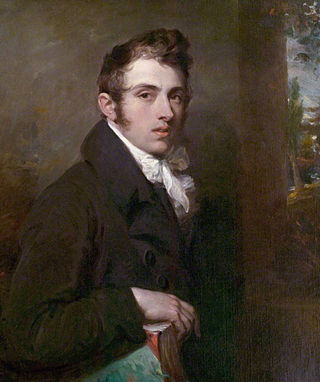
Stamford is a town and civil parish in the South Kesteven District of Lincolnshire, England. The population at the 2011 census was 19,701 and estimated at 20,645 in 2019. The town has 17th- and 18th-century stone buildings, older timber-framed buildings and five medieval parish churches. It is a frequent film location. In 2013 it was rated a top place to live in a survey by The Sunday Times. Its name has been passed on to Stamford, Connecticut, founded in 1641.

South Kesteven is a local government district in Lincolnshire, England, forming part of the traditional Kesteven division of the county. Its council is based in Grantham, and the district also covers Bourne, Market Deeping and Stamford. At the 2011 Census, the population of the district was 133,788, at 1.4 per hectare in 57,344 households.

Market Deeping is a market town and civil parish in the South Kesteven district of Lincolnshire, England, on the north bank of the River Welland and the A15 road. The population of the town at the 2011 census was 6,008.

Reading Museum is a museum of the history of the town of Reading, in the English county of Berkshire, and the surrounding area. It is accommodated within Reading Town Hall, and contains galleries describing the history of Reading and its related industries, a gallery of artefacts discovered during the excavations of Calleva Atrebatum, a copy of the Bayeux Tapestry, finds relating to Reading Abbey and an art collection.

William Hilton was a British portrait and history painter. He is also known as "William Hilton the Younger".

The Leicester Museum & Art Gallery is a museum on New Walk in Leicester, England, not far from the city centre. It opened in 1849 as one of the first public museums in the United Kingdom. Leicester Museum & Art Gallery contains displays of science, history and art, both international and local. The original building was designed by Joseph Hansom, designer of the hansom cab. It has been expanded several times, most recently in 2011.

The Collection is the county museum and gallery for Lincolnshire in England. It is an amalgamation of the Usher Gallery and the City and County Museum. The museum part of the enterprise is housed in a new, purpose-built building close by the Usher Gallery in the city of Lincoln.
Lincolnshire is one of the few counties within the UK that still uses the eleven-plus to decide who may attend grammar school, in common with Buckinghamshire and Kent.

Stamford Baron St Martin was a civil parish in Stamford, England, including the southern part of Stamford, south of the River Welland, and therefore historically part of Northamptonshire. It remains an ecclesiastical parish used by the Church of England; the parish church is St Martin's.

Weston Museum is a museum in Weston-super-Mare, North Somerset, England. It was established in 1861. and is home to North Somerset Council museum collection with exhibits relating to Weston-super-Mare and the surrounding area from 400 million years ago to the present day.

The Wisbech & Fenland Museum, located in the town of Wisbech in the Isle of Ely, Cambridgeshire, England, is one of the oldest purpose-built museums in the United Kingdom. The museum logo is W&F.

Rutland, archaically Rutlandshire, is a ceremonial county in the East Midlands of England. It borders Leicestershire to the north and west, Lincolnshire to the north-east, and Northamptonshire to the south-west. Oakham is the largest town.

Charles Read Academy is a co-educational secondary school located in Corby Glen, Lincolnshire, England. It serves the villages between Stamford, Bourne and Grantham.

The Parish Church of St Mary and St Augustine in Stamford, Lincolnshire, England, is home to a congregation of the Roman Catholic Diocese of Nottingham. St Augustine's was designed in a "robust High Victorian Early English" style by George Goldie, one of the foremost Catholic architects in England in the nineteenth century. It was built over 1862-64 and while much of its Victorian interior was stripped out in the middle decades of the twentieth century, it still retains some furnishings and fittings of distinction.

The United Reformed Church is a congregation in Stamford, Lincolnshire, based in a late-Georgian building situated on Star Lane.

The Church of St Michael the Greater is a late-Georgian Gothic church in Stamford, Lincolnshire which stands on the south side of Stamford High Street on the site of an earlier, Medieval predecessor. The church is a Grade II listed building as, separately, is the churchyard wall.

The Playhouse is a theatre in Sleaford, Lincolnshire, England. It is a Grade II listed Georgian building dating from 1820. The building became a school in the 1850s, and after serving several other purposes reopened as a theatre in 2000.

The Usher Gallery is an art museum in Lincoln, England. The gallery displays a collection of artworks by painters such as J. M. W. Turner and L. S. Lowry. Established in 1927, it is run as part of the Collection.

The Angles Theatre is a theatre and historic Georgian playhouse in the market town of Wisbech, Isle of Ely, Cambridgeshire, England. It is among the oldest of Britain's theatres. The current premises consists of the original theatre building and a former library, originally an 'infant' school built in 1837, both of which are Grade II listed. The patrons are Sir Derek Jacobi, Jo Brand, Claire Tomalin and Dame Cleo Laine.

Stamford Town Hall is a municipal building in St Mary's Hill, Stamford, Lincolnshire, England. The building, which was the headquarters of Stamford Borough Council, is a Grade II* listed building.




















